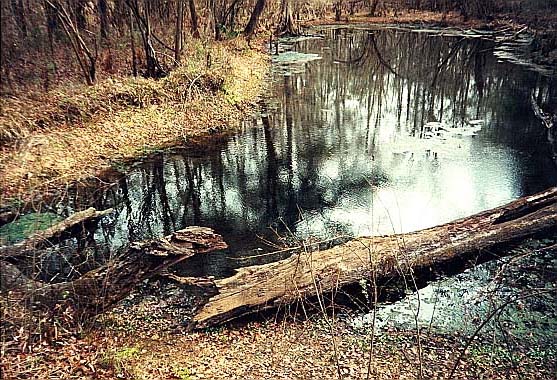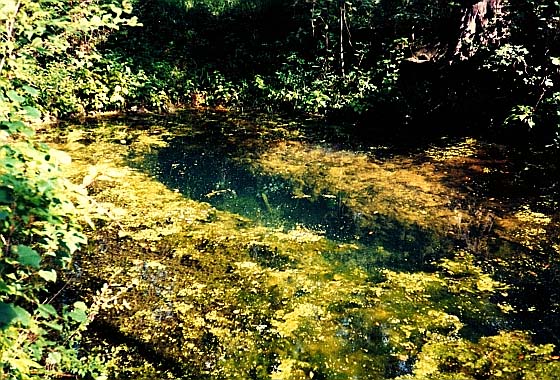Allen Mill Pond Spring
Lafayette County
Summary of Features
- Scale -2nd magnitude
- Scenery -outstanding
- How Pristine? -very pristine; little evidence of past use as mill, campground, and homestead
- Swimming -no
- Protection -excellent
- Wildlife -very good
- Crowds -none
- Access -good
- Facilities -none
- Safety -good
- Scuba -no
- Cost -free

Directions
Web link for info and map: www.srwmd.state.fl.us/index.aspx?nid=232. Allen Mill Pond from Dowling Park: Cross the Suwannee River on CR 250, turn left on NW CR 251; travel 8 miles to CR 292, turn left on CR 292; travel 3 miles and the paved road makes a 90-degree turn to the right, turn right and the entrance to Lafayatte Blue Springs State Park is a short distance on the left. Allen Mill Pond from Mayo: Travel north on US 27, turn right on CR 292; travel north on CR 292 4 miles and the entrance to Allen Mill Pond is on the right.
Spring Description
The spring lies in a low swampy karst area that is pockmarked with sinkholes and surface limestone. The area around the spring is wooded floodplain, with cypress and hardwood trees in abundance and dense vegetation in the summer. The first and main vent is at the head of the elongated pool andis a canoe-shaped opening in the limestone with a gentle boil. It is 4-6 feet deep, about 3 feet wide, and 9 feet long.
The spring pool or first part of the run--which ends in a 90-degree turn where there is a small dam that is the remnant of a 19th century corn mill--is S-shaped and approximately 175 feet long. It is shallow and the water is clear. The run continues after the dam for about 1,000 yards to the Suwannee and is from 1-3 feet deep. The authors found a second vent near the head vent, but not three vents as described in Rosenau et al. (1977, p. 198).
Use/Access
- The site is managed by the Suwannee River Water Management District and offers hiking, biking, horseback riding, camping, and fishing as well as 1.6 miles of river frontage.
- The protected area also includes upland pine forest, hardwood forest, bottomland forest, and swamp that serve as habitat for bobcat, beaver, turkey, fox, quail, and wild hogs ("Allen Mill Pond," SRWMD flyer, n.d.).
- It might be possible to canoe up the run to the spring when the river is high, but the run is shallow and obstructed at other times.
- As the winter and summer photographs of the spring suggest, the area surrounding Allen Mill Pond is heavily overgrown in summer, making access and viewing difficult and less safe.
Local Springiana
The spring has a rich history. It was the site of a corn mill built in 1855, a settlement, a ferry concession, a trading post, a sand mining operation, and a campground. Evidence of these activities is almost completely gone, and the area has a very wild character.
In an historical footnote, Louis Moseley, a 19th century landowner, sheltered Confederate Secretary of War John Breckenridge at the site of the spring in 1865 after Lee’s surrender to Grant. Breckenridge was fleeing Federal troops and trying to divert their attention from the simultaneous flight of Confederate President Jefferson Davis. Breckenridge would ultimately make good his escape all the way to Cuba and exile, while Davis was captured in south Georgia and imprisoned for two years (Johnson & Faircloth, 1996, p. 50, and Foote, p. 1,010).
Personal Impressions
The site is lovely, wild, picturesque, and remote, making it a favorite of the authors in terms of its natural beauty. It is best to visit in winter, for the lush terrain is wildly overgrown in summer.
Nearby Springs
- Flynn Spring
- Charles Spring
- Thomas Spring
- Lafayette Blue Spring





